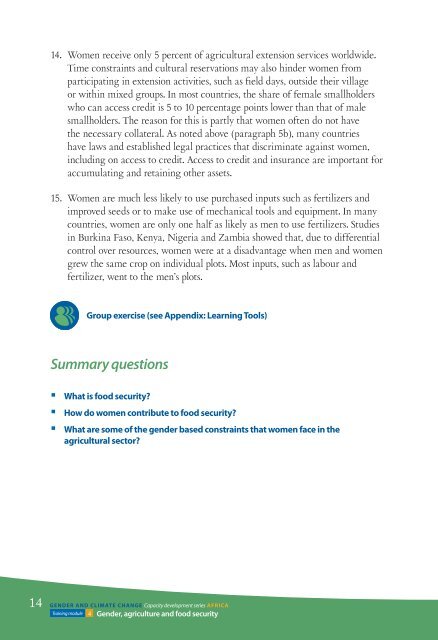Module 4: Gender, Agriculture and Food Security - Gender Climate
Module 4: Gender, Agriculture and Food Security - Gender Climate Module 4: Gender, Agriculture and Food Security - Gender Climate
14. Women receive only 5 percent of agricultural extension services worldwide. Time constraints and cultural reservations may also hinder women from participating in extension activities, such as field days, outside their village or within mixed groups. In most countries, the share of female smallholders who can access credit is 5 to 10 percentage points lower than that of male smallholders. The reason for this is partly that women often do not have the necessary collateral. As noted above (paragraph 5b), many countries have laws and established legal practices that discriminate against women, including on access to credit. Access to credit and insurance are important for accumulating and retaining other assets. 15. Women are much less likely to use purchased inputs such as fertilizers and improved seeds or to make use of mechanical tools and equipment. In many countries, women are only one half as likely as men to use fertilizers. Studies in Burkina Faso, Kenya, Nigeria and Zambia showed that, due to differential control over resources, women were at a disadvantage when men and women grew the same crop on individual plots. Most inputs, such as labour and fertilizer, went to the men’s plots. Group exercise (see Appendix: Learning Tools) Summary questions • What is food security • How do women contribute to food security • What are some of the gender based constraints that women face in the agricultural sector 14 Gender and Climate Change Capacity development series Afric a Training module 4 Gender, agriculture and food security
VI Incorporating gender perspectives to improve agricultural development and food security Learning objective: Identify appropriate policy responses to address gender gaps in agriculture and food security 16. Empowering women and girls is critical for agricultural development and food security (World Bank 2009), but there is also a strong economic rationale for this: if women farmers were given the same access to resources, such as finance, women’s agricultural yields could increase by 20 to 30 percent; national agricultural production could rise by 2.5 to 4 percent; and the number of malnourished people could be reduced by 12 to 17 percent (FAO 2011b; Bertini 2011). It has recently been observed that, if African women were given equal access as men to vocational training and technology, the continent’s economy would expand by at least 40 percent (Krause-Jackson 2011). Box 3 provides a notable ongoing effort to address gender issues in agriculture in the Southern African Development Community (SADC). RAP: SADC Regional Agricultural Policy (RAP) PGD: SADC Protocol on Gender and Development (PGD) Gender and Climate Change Capacity development series Afric a Gender, agriculture and food security Training module 4 15
- Page 1 and 2: Empowered lives. Resilient nations.
- Page 3 and 4: I. Purpose of the training module 2
- Page 5 and 6: ÒÒThe different roles of men and
- Page 7 and 8: III Key messages ÒÒIn Africa, agr
- Page 9 and 10: Water scarcity, climate change and
- Page 11 and 12: Figure 2: Examples of current and p
- Page 13 and 14: V Gender-differentiated impacts of
- Page 15: 10. Finally, in food utilization (u
- Page 19 and 20: 17. The following are a set of reco
- Page 21 and 22: Figure 4: Integrating gender into a
- Page 23 and 24: Appendix A. Case studies Case study
- Page 25 and 26: Case study 3 Gender, international
- Page 27 and 28: Case study 4 Climate change and wom
- Page 29 and 30: Appendix B. Learning tools Task 1:
- Page 31 and 32: References Arend, Elizabeth (2011).
- Page 33 and 34: Notes
- Page 36: Empowered lives. Resilient nations.
14. Women receive only 5 percent of agricultural extension services worldwide.<br />
Time constraints <strong>and</strong> cultural reservations may also hinder women from<br />
participating in extension activities, such as field days, outside their village<br />
or within mixed groups. In most countries, the share of female smallholders<br />
who can access credit is 5 to 10 percentage points lower than that of male<br />
smallholders. The reason for this is partly that women often do not have<br />
the necessary collateral. As noted above (paragraph 5b), many countries<br />
have laws <strong>and</strong> established legal practices that discriminate against women,<br />
including on access to credit. Access to credit <strong>and</strong> insurance are important for<br />
accumulating <strong>and</strong> retaining other assets.<br />
15. Women are much less likely to use purchased inputs such as fertilizers <strong>and</strong><br />
improved seeds or to make use of mechanical tools <strong>and</strong> equipment. In many<br />
countries, women are only one half as likely as men to use fertilizers. Studies<br />
in Burkina Faso, Kenya, Nigeria <strong>and</strong> Zambia showed that, due to differential<br />
control over resources, women were at a disadvantage when men <strong>and</strong> women<br />
grew the same crop on individual plots. Most inputs, such as labour <strong>and</strong><br />
fertilizer, went to the men’s plots.<br />
Group exercise (see Appendix: Learning Tools)<br />
Summary questions<br />
• What is food security<br />
<br />
<br />
• How do women contribute to food security<br />
• What are some of the gender based constraints that women face in the<br />
agricultural sector<br />
14<br />
<strong>Gender</strong> <strong>and</strong> <strong>Climate</strong> Change Capacity development series Afric a<br />
Training module 4 <strong>Gender</strong>, agriculture <strong>and</strong> food security



